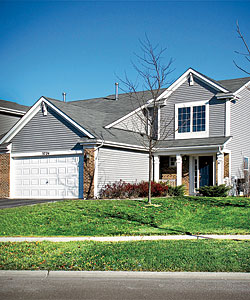
Linda Serafini at her family’s new home in Lockport
Like many builders with unsold inventory, Lexington Homes had tried different incentives to get would-be homeowners to sign on the dotted line. Among the roadblocks the company confronted were potential clients who would have gladly moved up to a larger house—if only they weren’t stuck in a too-small home they couldn’t sell.
Now Jeff Benach, a coprincipal at Lexington, says that he has found a way to encourage those people that they can afford to move. The credit goes to a new business model devised by the burgeoning Michigan-based Marketplace Homes.
Here’s how it works. Buy a new house from one of 11 Chicago-area builders, and Marketplace will manage your old home as a rental for up to six years. According to Mike Kalis, the company’s founder and managing partner, Marketplace covers all utilities and handles all maintenance and repairs. You get an agreed-upon monthly check—based on current market rates—whether or not your former residence is leased out. Best of all, you pay Marketplace nothing; instead, it collects a commission from the homebuilder. If after six years your home hasn’t sold, it reverts back to you. Marketplace, which operates in 25 cities, has struck bargains with 166 Chicago-area homeowners—and its work here has earned it an A-plus rating from the Better Business Bureau.

The Serafinis’ rented townhouse
Last July, working with William Ryan Homes and Marketplace, Linda and Matthew Serafini were able to afford a new $330,000 four-bedroom house in Lockport. The couple had paid $230,000 in 2006 for a two-bedroom townhouse in Joliet. After their daughter, Mia, was born, they desperately wanted to move into a larger residence, but they learned that their townhouse was now appraised at about $155,000. “We couldn’t sell it for that,” Linda says. “It would be too much of a loss.”
The Serafinis now carry two mortgages, but they receive a monthly rent check that covers the payment on the Joliet property and leaves them with an extra $50. “We didn’t see it as a gamble,” says Linda, who teaches family and consumer science at Schaumburg High School (her husband is a banker). “We saw it as an educated risk. In six years, we hope the real-estate market will be at a point where we can afford to sell the townhouse.”
As for Lexington Homes, it sold three houses in 2011 with help from Marketplace. “It’s bringing back demand for our product,” Benach says. Lexington is offering homes under the same arrangement at its Lexington Square development in the Bridgeport neighborhood and Lexington Park 2 in Des Plaines. In addition to Lexington and William Ryan, other area homebuilders working with Marketplace are Centex, Del Webb, The Jacobs Companies, K. Hovnanian/Town & Country, Lennar, Orleans, Pulte, Ryland Homes, and West Point.
Kalis says that at least half of Marketplace clients break even on the rental deal. Most others contribute a portion of the payment on their earlier home. “Even if they have to kick in a few hundred dollars [each month] on the mortgage, they find that, with the tax advantage of a rental property, it works out,” he says.
At the end of each year, the company reassesses and may adjust the rental amount down, but so far that has happened only once. Homeowners have an annual opportunity to opt out of the deal, says Kalis. If Marketplace buys or sells your home during the course of the agreement, you get 100 percent of your asking price. Hopefully by then you won’t have grown too accustomed to receiving that monthly rental check without having to endure the hassles of being a landlord.
Send tips about home sales to dennis@rodkin.com.
Photography: (top) Chris Guillen; (right) Todd Urban


